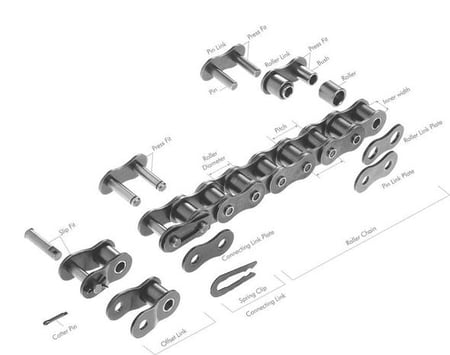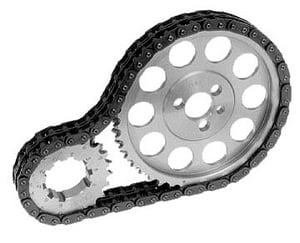Knowing when to replace your roller chain is an important part to your power transactional process. This is because wear and tear at any point of the roller chain (also known as a drive chain or conveyor chain) will cause damage to other components of the process such as the cogs, sprockets or pins.
Unfortunately, if damage to the roller chain is not identified soon enough, it will begin to affect the other components, they can be much more expensive to replace.
This is why it’s important to understand and recognise the signs of wear to the roller chain and find your nearest drive chain distributor or conveyor chain manufacturer as quickly as possible with your order.
We want to be able to help you find the right type of products or solutions when it comes to replacing manufacturing and mechanical components. So here, we’ve put together a small guide for you:
What is a Roller Chain?
A roller chain, conveyor chain or drive chain is a – you guessed it – chain, that comprises of 5 compartments; the roller, bushing, pins, master link, as well as the outer plates and inner plates. Together they form a long chain that can be partnered with a sprocket or cog to help convey power from a motor to a cog and so on.

The compartments that make up a roller chain (Image: Tsubaki)
1. Roller
This is a metal cylindrical casing that will surround the bushing. It is designed this way so that all parts can move freely and allow for a flexible chain. There is lubrication between these components that needs to be maintained to prevent wear and tear.
2. Bushing
This is another hollow metal cylindrical casing that surrounds the pins but is inside of the rollers. Not only this, but the bushing is attached to the inner plates. The inner plate is peanut-shaped with a bushing cylinder at each end.
3. Bearing Pins (A.K.A rivets)
This is a strengthened and solid mental cylinder that is inserted inside bushing with lubrication to allow for free movement. Just like the bushing, the bearing pins are attached to a plate (outer) which is peanut-shaped with two pins attached on either side.
4. Inner and Outer Plates
These plates, as mentioned, are peanut-shaped with bushing and bearing pins attached. They are connected and interlocked by the pins entering the bushing cases. They interchange to create a long chain; the first pin matches with the last bushing case and then the first bushing case matches with the last pin of a different plate. They are all encased together with the roller on top of the bushing.
5. Master Link
This is a specially designed link used to secure a chain together. There is not always a need for a master link as there are certain lengths that are standard and made by a conveyor chain manufacturer as a specific size.
What Are the Applications of a Roller Chain?
The roller chain has been seen by most people, especially if they have grown up with a bike or two. The chain used to connect the gears to the wheels is a drive chain used with sprockets.
 Roller chains and sprockets are commonly used together in vehicles such as bicycles and motorcycles
Roller chains and sprockets are commonly used together in vehicles such as bicycles and motorcycles
However, they can also be used for industrial applications such as the motor industry and in construction.
A drive chain distributor will manufacturer larger roller chains for motorbikes but is often used in the same way as bicycles. However, for newer bikes, this is substituted for alternatives such as the v-belt.
In cars, a roller chain is a safe and durable choice for cars where the chain is attached from the engine as a power transmission to drive the camshaft. Again, however, this is more common in older models and is often substituted for toothed belts for quieter running.
They are also seen in forklifts, chainsaws and printer processes.
How Can You Maintain a Roller Chain?
Maintaining a roller chain can be as simple as checking for elongation and providing lubrication as per the manufacturer’s guidelines.
You should routinely inspect the drives for the correct chain tension. Chains should be installed with 2% to 4% of sag in the center of the sprocket distance.
You could also use a gauge to measure and check the true chain pitch to the original chain pitch. A conveyor chain manufacture will recommend replacing the chain after 3% elongation. Otherwise, this can be maintained and used again.
While not always necessary, it is recommended to replace the sprockets every time the roller chain is replaced. This is because wear and tear of the chain will ride up the sprockets and cause long-term damage to the cogs, too.
There are also ways to prolong the life of your roller chains. Check out our quick guide here to learn more.
What Are the Signs of Wear and Tear?
The signs of wear and tear for a roller chain can be straight-forward in that the chain will show elongation.
A roller chain should be secure and not ‘stretch’ as if the chain is elasticated. This can also be measured with the sag and the chain pitch as mentioned above. If you’re not sure how to measure this elongation of the roller chain, then most driver chain distributors and conveyor chain manufacturers will provide a tool called a ‘chain wear scale’.
Otherwise, if you already have a tool, you can apply the following calculation:
- Extend the roller chain until it is taut
- Using a Vernier Caliper, measure the distance from the inside of one roller to the outside of the next. Do this a few times in different locations.
- Add these numbers together and then divide by the number of times you measured (e.g. 1+1+1+1 divided by 4, or 2+2+2 divided by 3). This presents the average length between rollers.
- Then, multiply this average length by the number of links in the chain. This will provide the true length of the chain.
- Knowing the original chain length, you can find out the percentage of chain elongation by dividing the true length by the original chain length and then multiplying this result by 100.
How Do You Know When it is Time to Replace Your Roller Chain?
After the above calculation has been completed you will be presented with the percentage of roller chain elongation. The majority of conveyor chain manufacturers will state that the rate of elongation must not exceed 3%. If it is 3% or above, it is time to replace your roller chain.
If the roller chain has not been replaced, it can cause the chain to dislodge from the sprockets and cogs and cause a power transmission failure with broken links causing potential damage to other components of the product.
However, it is also important to check in with the recommendations from the conveyor chain manufacturers and the distributors of the product the chain is being used on. For example, in lots of bikes with high-gear potential, they will only recommend a chain elongation of 0.75% before needing to be changed.
There you Have It!
So, there you have it, a guide to knowing when it is time to replace your roller chain.
If you would like to find out more information or to find a new chain, check out SLS Bearings as your drive chain distributor and you’ll be pointed in the right direction in no time. Contact us today!







